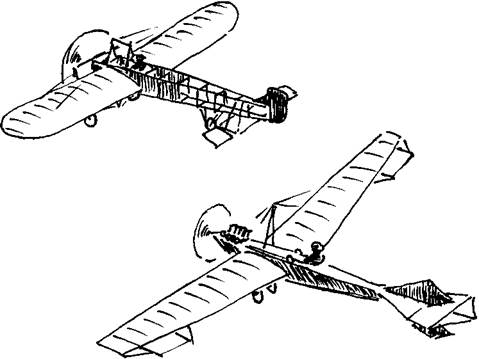The Problem of Control
Otto Lilienthal (1848-1896), Sir Hiram Maxim (1840-1916), and Dr. Samuel Pierpont Langley (1834-1906) followed the empirical route, much as did the Wrights, but they failed to demonstrate man-carrying mechanical flight mainly because they underestimated the problem of control. Lilienthal died of a broken back after losing control of his hang glider. Langley’s airplane flew stably in uncontrolled flight as a quarter-scale model but broke up twice in full-scale launches. Maxim’s steam-driven airplane might have flown, but it broke free of the down-holding rails on its test track and was wrecked.
|
Figure 1.1 Two early flying machines with inherent longitudinal and lateral stability, the Bleriot XI Cross-Channel airplane (above) and the Levavasseur Antoinette IV (below). Both used pronounced wing dihedral, unlike the Wright Flyers. |
Maxim’s well-engineered failure has had a continuing fascination for modern aeronautical engineers. Bernard Maggin, a noted stability and control engineer with a long career at NACA and the National Research Council, has done extensive research into Maxim’s work for the National Air and Space Museum. Another stability and control expert, W. Hewitt Phillips, built and flew a rubber-powered, dynamically scaled, scale model of Maxim’s large machine. In unpublished correspondence Phillips reports as follows:
The model flies fine, despite the lack of vertical tail on the configuration that Maxim used when he ran it on tracks. It flies like a twin pusher, which is what it is. The big propellers aft of the center of gravity give it a marginal amount of directional stability. …Of course, the Reynolds number is far from the full-scale value, but this may not be very important since Maxim used thin airfoils….
My conclusion is that Maxim’s airplane would have flown, at least as a giant free-flight model…I feel that Maxim should get more credit for his engineering contributions than has been given by historians.
The Wrights, on the other hand, addressed the control problem head-on. They taught themselves to fly with three experimental biplane gliders, each fitted with warpable wings for lateral control and all-moving foreplanes for pitch control. The third incorporated an all-moving vertical tail coupled to the wing warp for suppression of adverse yaw due to lateral control actuation, and they learned to fly it quite nicely by 1902. They applied for a patent, describing coupled lateral, or roll and yaw, controls.
In 1903 the Wrights built a powered machine based on the 1902 glider, with a four – cylinder gasoline engine geared to turn its two propellers, and they designed and built the engine and propellers too. They flew it first on 17 December 1903. Modem analysis by Professor Fred E. C. Culick and Henry R. Jex (1985) has demonstrated that the 1903 Wright Flyer was so unstable as to be almost unmanageable by anyone but the Wrights, who had trained themselves in the 1902 glider. In 1904 and 1905 the Wrights improved the lateral stability of their 1903 airplane by removing the downward arch of the wings as seen from the front (the so-called cathedral), reduced its longitudinal instability by ballasting it to be more nose-heavy, and improved its lateral control by removing the mechanical roll-yaw control interconnect.
Henceforth, appropriate roll-yaw control coupling would be provided by pilot skill. Finally, the Wrights learned to sense wing stall, especially in turning flight, and to avoid it by nosing down slightly. By practice they became masters of precision flight in their unstable machine. They also received a patent for their control innovations on 22 May 1905. Confident of their skill and achievements, they built two new machines and sent one to France in 1907.












